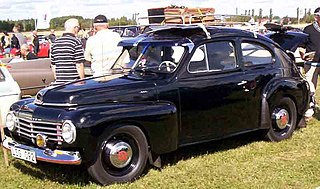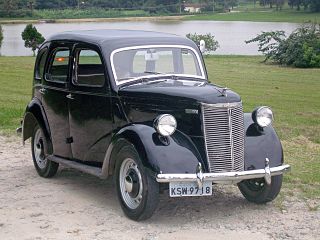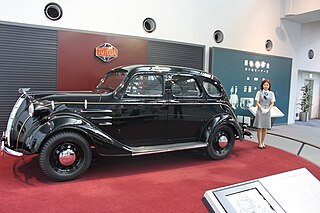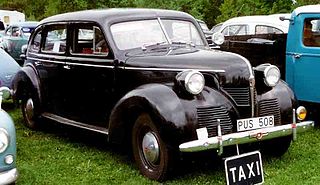
The Duett is an automobile from Volvo that was in production from 1953 to 1969.

The Volvo PV is a series of two-door, four-passenger car models — the PV444 and the PV544 — made by Volvo from 1947 to 1966. During World War II's early stages, Volvo decided that a new, smaller car that could deliver good fuel economy would assure the company's future. A raw materials shortage during the war drove home the point that an automobile should be smaller, and also complicated Volvo's ability to mass-produce the product. In 1944, when the car was finally introduced to a car-hungry public, response was very positive and orders poured in from the Swedish population. It was another three years though, until 1947, before series production began.

The Ford Prefect is a line of British cars which was produced by Ford UK between 1938 and 1961 as an upmarket version of the Ford Popular and Ford Anglia small family cars. It was introduced in October 1938 and remained in production until 1941. Returning to the market in 1945, it was offered until 1961. The car progressed in 1953 from its original perpendicular or "sit-up-and-beg" style to a more modern three-box structure. Some versions were also built and sold by Ford Australia.

The Volvo 140 Series is a line of mid-size cars manufactured and marketed by Volvo from 1966 to 1974 in two- and four-door sedan as well as five door station wagon body styles—with numerous intermediate facelifts. More than a million Volvo 140s were built.

The Volvo 164 is a 4-door, 6-cylinder luxury sedan unveiled by Volvo at the Paris Motor Show early in October 1968 and first sold as a 1969 model. 46,008 164s were built before the car was succeeded by the 264 in 1975. The 164 was Volvo's first venture into the luxury segment since the end of PV 60 production in 1950, and was the first six-cylinder Volvo since the PV800 last produced in 1958.

Ford 7Y is a car built by Ford UK from 1938 until 1939. During that time 65,098 cars were produced.

The Volvo PV800 Series was a taxicab manufactured by Volvo between 1938 and 1958. The Sow series dominated the Swedish taxicab market during the 1940s and 1950s.

Duple Coachbuilders was a coach and bus bodybuilder in England from 1919 until 1989.

The Volvo ÖV 4 was the first car built by Volvo. The designation ÖV 4 stands for "Öppen Vagn 4 cylindrar" in Swedish, which means Open Carriage, 4 cylinders. The model ÖV 4 has later often been referred to as "Jakob" but that was just a name for one of the 10 pre-series ÖV 4 that was ready on 25 July 1926, Jakob's name day. All 10 prototypes were assembled in Stockholm at the company AB Galco, Hälsingegatan 41 where Gustaf Larson worked at that time. Only one of the 10 pre-series cars manufactured during 1926 was saved for posterity and is housed at the Volvo Museum in Gothenburg, Sweden.

The Volvo PV 36 Carioca is a luxury car manufactured by Volvo Cars between 1935 and 1938. The word Carioca describes someone from Rio de Janeiro, Brazil, and was also the name of a dance that was fashionable in Sweden at the time when the car was introduced.

The Riley Nine was one of the most successful light sporting cars produced by the British motor industry in the inter war period. It was made by the Riley company of Coventry, England with a wide range of body styles between 1926 and 1938.

The A1 was the first prototype passenger car built by the company that became Toyota. It was redesigned and put into production as Toyota's first production cars, the AA sedan and the AB cabriolet. These were succeeded by the similar AE, AC and BA sedans.
Volvo PV is a model name that Volvo used on a number of automobiles during the company's first forty years:

The Peugeot 402 is a large family car produced in Sochaux, France from 1935 to 1942 by Peugeot. It was unveiled at the Paris Motor Show in 1935, replacing the Peugeot 401.

The Austin Light Twelve-Four is a car that was produced by Austin from 1933 until 1939. It was replaced in 1939 by a completely new car also called the Austin 12 which kept the same engine. The "12" in the name referred to the taxation horsepower, a British rating which controlled the annual taxation payable to use the car on the road.

The Volvo PV60 is an automobile manufactured by Volvo between 1946 and 1950. It was the first car produced by the Swedish company after the end of the Second World War.

The Volvo PV650 Series is an automobile manufactured by Volvo between 1929 and 1937. The model name stand for PersonVagn, 6 cylinders, 5 seats; the third digit indicates the version.

The Volvo TR670 Series was a taxicab manufactured by Volvo between 1930 and 1937. The model name stands for TRafikvagn ("taxicab"), 6 cylinders, 7 seats; the third digit indicates the version.

The Chevrolet Master and Master Deluxe are American passenger vehicles manufactured by Chevrolet between 1933 and 1942 to replace the 1933 Master Eagle. It was the more expensive model in the Chevrolet range at this time, with the Standard Mercury providing an affordable product between 1933 and 1937. Starting with this generation, all GM cars shared a corporate appearance as a result of the Art and Color Section headed by Harley Earl. From 1940 a more expensive version based on the Master Deluxe was launched called the Special Deluxe. The updated corporate appearance introduced a concealed radiator behind a façade with a grille.

The Vivaquatre is a car produced by Renault between 1932 and 1939. Its large 4-cylinder engine placed it initially in the 10CV car tax class, though a larger engine later made it a contender in the 11CV class.
























